Commercial Meat Processing Equipment Guide

Table of Contents
Essential meat processing equipment for restaurants and delis
Commercial meat processing equipment transforms raw proteins into ready-to-serve products, enabling restaurants, delis, and foodservice operations to offer fresh, consistent menu items while maintaining food safety standards. From industrial meat grinders that produce hundreds of pounds per hour to precision slicers that ensure uniform portions, these specialized tools handle the heavy-duty demands of protein preparation. Built for continuous use in demanding environments, they feature stainless steel construction, powerful motors, and safety mechanisms designed for commercial kitchens. This comprehensive guide covers all major equipment types, selection criteria, and operational considerations to help you build an efficient meat processing station that maximizes yield and minimizes waste.
Benefits of Professional Meat Processing
Investing in commercial meat processing equipment pays dividends through consistent quality, portion control, and menu expansion. Restaurants using professional equipment achieve 20-30% better yield compared to manual methods, while automated processes ensure food safety compliance and reduce labor costs. From grinders that produce uniform textures to slicers that eliminate waste, these tools transform bulk proteins into premium menu items that drive customer satisfaction and profitability.
Types of Commercial Meat Processing Equipment
Commercial meat processing equipment falls into several categories based on function, from grinding and mixing to slicing and portioning. Each type serves specific operational needs in restaurants, delis, butcher shops, and foodservice facilities.
Meat Grinders & Choppers
Meat grinders reduce whole cuts into ground meat of various textures, essential for burgers, sausages, meatballs, and processed meats in high-volume operations. Heavy-duty models feature powerful motors, large feed hoppers, and multiple grinding plates for different consistencies.
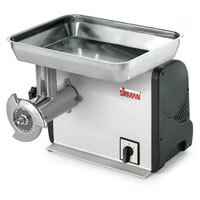
- Best Uses: Restaurants producing daily burger patties, sausage shops, delis grinding fresh meats, food trucks needing portable processing
- Capacities: 1-5 HP motors; 1-10 lbs/minute output depending on model; commercial units process 100+ lbs/hour
- Features: Reverse function for jams, multiple grinding plates (coarse/fine), stainless steel construction, removable parts for cleaning
- Pros: Consistent texture, high throughput, easy to clean, versatile for different meats
- Cons: Requires regular maintenance of blades, noise during operation, takes up counter space
Meat Slicers
Meat slicers produce uniform slices for deli meats, cheeses, and portioned proteins, ensuring consistent presentation and reducing waste. Commercial models feature powerful motors, large blades, and safety mechanisms for high-volume slicing.

- Best Uses: Delis slicing cold cuts, restaurants portioning meats and cheeses, catering operations, sandwich shops
- Capacities: 8-14 inch blades; slice thickness from paper-thin to 1/2 inch; commercial models handle 20+ lbs per minute
- Features: Removable blades, slice thickness adjustment, food carriage with grip, safety interlocks, built-in sharpeners
- Pros: Precise portions, reduces waste, fast operation, consistent results
- Cons: Requires regular blade sharpening, cleaning intensive, safety training needed
Meat & Bone Saws
Meat and bone saws cut through bones, frozen meats, and tough cuts with precision, essential for butcher operations and restaurants breaking down large primal cuts. Commercial models feature powerful motors and specialized blades designed for continuous use.
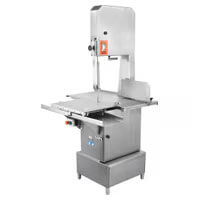
- Best Uses: Butcher shops fabricating cuts, restaurants breaking down wholesale meats, institutions processing large quantities
- Capacities: 1-2 HP motors; 8-10 inch blades; cut through 6+ inch thick frozen meat
- Features: Removable blades, adjustable fences, bone collection trays, cooling systems to prevent overheating
- Pros: Fast cutting, precise results, handles frozen products, reduces labor
- Cons: High noise level, requires proper maintenance, safety gear essential
Sausage Stuffers & Jerky Shooters
Sausage stuffers fill casings with meat mixtures for sausages, while jerky shooters create uniform jerky sticks. Commercial models handle large volumes and various casing sizes for consistent production.

- Best Uses: Sausage shops, restaurants with house-made charcuterie, delis producing specialty sausages, food manufacturers
- Capacities: 5-25 lbs capacity; stuff 10-50 lbs/hour depending on model; multiple nozzle sizes
- Features: Vertical/horizontal designs, portioning controls, easy-clean surfaces, compatible with natural/synthetic casings
- Pros: Consistent filling, reduces air pockets, fast production, versatile for different products
- Cons: Learning curve for operation, casing preparation required, cleaning intensive
Meat Tenderizers & Marinators
Meat tenderizers break down tough muscle fibers, while marinators infuse flavors and tenderize proteins. Commercial models combine both functions for efficient preparation of steaks, roasts, and bulk proteins.
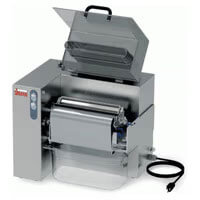
- Best Uses: Steakhouses tenderizing cuts, restaurants marinating large quantities, catering operations, institutional kitchens
- Capacities: Tenderize 50-200 lbs/hour; marinade tanks hold 50-500 gallons
- Features: Blade/needle systems for tenderizing, vacuum marinade for faster penetration, programmable cycles
- Pros: Improves texture and flavor, reduces cooking time, consistent results, batch processing
- Cons: Requires proper technique, marinade management needed, equipment maintenance
Meat & Sausage Mixers
Meat mixers blend ground meat with seasonings, fats, and binders for sausages, burgers, and processed meats. Commercial models feature powerful motors and specialized paddles for thorough, consistent mixing.
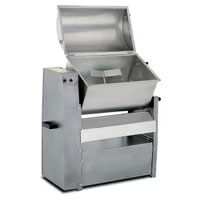
- Best Uses: Sausage production, burger manufacturing, meat processing facilities, restaurants making house blends
- Capacities: 25-200 lbs capacity; mix 50-300 lbs/hour; bowl capacities from 25-150 quarts
- Features: Variable speed controls, stainless steel bowls, safety interlocks, easy-to-clean designs
- Pros: Thorough mixing, prevents separation, fast processing, consistent quality
- Cons: Bowl changes required for different batches, cleaning between flavors, space intensive
Meat & Hamburger Presses
Hamburger presses form uniform patties from ground meat, ensuring consistent size, weight, and cooking results. Commercial models handle high volumes and integrate with automated production lines.
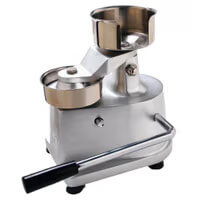
- Best Uses: Fast-casual restaurants, burger chains, delis, food manufacturers producing pre-formed patties
- Capacities: Form 1,200-3,600 patties/hour; 1/3 to 1 lb patty sizes; multiple mold options
- Features: Portion control, paper interleaving, automated stacking, adjustable pressure settings
- Pros: Consistent portions, faster service, reduces waste, professional appearance
- Cons: Requires consistent meat texture, mold cleaning needed, single-purpose equipment
Meat Curing Chambers
Meat curing chambers provide controlled environments for dry curing, smoking, and aging meats, creating specialty products like prosciutto, bacon, and aged steaks.
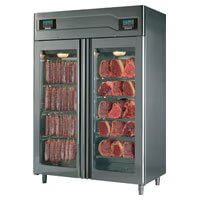
- Best Uses: Specialty butcher shops, restaurants with charcuterie programs, high-end delis, artisanal meat producers
- Capacities: 50-500 cu ft chambers; temperature ranges 34-200°F; humidity control 40-90%
- Features: Digital controls, humidity monitoring, air circulation, shelving systems
- Pros: Creates premium products, extends shelf life, consistent results, adds menu value
- Cons: Long curing times, space requirements, specialized knowledge needed
Food Dehydrators
Food dehydrators remove moisture from meats, fruits, and vegetables, creating jerky, dried fruits, and preserved products. Commercial models feature multiple trays and precise temperature control.

- Best Uses: Restaurants making beef jerky, health-focused cafes, snack manufacturers, catering operations
- Capacities: 10-30 trays; dehydrate 10-50 lbs per batch; temperatures up to 160°F
- Features: Stackable trays, digital controls, air circulation, stainless steel construction
- Pros: Creates shelf-stable products, adds menu variety, low operating costs, batch processing
- Cons: Long dehydration times (4-24 hours), requires proper storage, limited to dry climates
Chicken Slicers
Specialized slicers designed for poultry processing, featuring smaller blades and gentler handling for delicate chicken products. Commercial models ensure clean cuts for chicken breasts, tenders, and filets.

- Best Uses: Chicken-focused restaurants, fast-casual chains, delis, institutional kitchens
- Capacities: 8-12 inch blades; slice 20-50 lbs/hour; thickness from 1/8-1 inch
- Features: Gentle feed systems, portion control, easy-clean designs, safety features
- Pros: Specialized for poultry, reduces waste, consistent portions, fast operation
- Cons: Poultry-specific use, blade maintenance required, cleaning intensive
Seafood Prep Appliances & Tools
Specialized equipment for processing fish and seafood, including filleting machines, shrimp peelers, and portioning tools designed for delicate seafood handling.
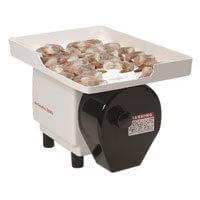
- Best Uses: Seafood restaurants, sushi bars, fish markets, catering operations serving seafood
- Capacities: Varies by equipment; filleting machines process 50-200 lbs/hour
- Features: Gentle handling systems, portioning controls, stainless steel construction, easy cleaning
- Pros: Specialized for seafood, reduces labor, consistent results, maintains quality
- Cons: Equipment-specific use, requires seafood expertise, maintenance intensive
Meat Processing Accessories
Essential supporting equipment including blades, parts, and maintenance tools that keep meat processing operations running smoothly.
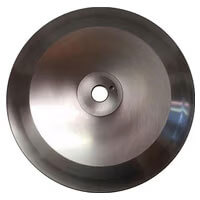
- Blade Sets: Replacement blades for saws, slicers, and grinders in various sizes and tooth counts
- Parts Kits: Gaskets, bearings, and components for equipment maintenance
- Sharpening Tools: Professional sharpening systems for blades and cutting surfaces
- Safety Equipment: Guards, gloves, and safety gear for operator protection
Equipment Comparison Table
| Equipment Type: | Capacity Range: | Best For: | Key Features: | Price Range: |
| Meat Grinders | 1-10 lbs/min | High-volume grinding | Multiple plates, reverse function | $500-3,000 |
| Meat Slicers | 20+ lbs/min | Deli operations | Adjustable thickness, safety features | $800-2,500 |
| Meat Saws | 6+ inch cuts | Fabrication | Bone collection, cooling systems | $1,000-4,000 |
| Sausage Stuffers | 10-50 lbs/hour | Sausage production | Multiple nozzles, portion control | $300-1,500 |
| Meat Mixers | 50-300 lbs/hour | Batch mixing | Variable speeds, safety interlocks | $1,500-5,000 |
| Hamburger Presses | 1,200-3,600/hour | Patty production | Portion control, interleaving | $2,000-8,000 |
| Meat Tenderizers | 50-200 lbs/hour | Texture improvement | Blade/needle systems | $1,000-3,500 |
| Food Dehydrators | 10-50 lbs/batch | Jerky production | Multiple trays, temperature control | $800-3,000 |
*Note: Capacities vary by specific model and meat type; always verify manufacturer specifications.*
Selection Factors
Choose meat processing equipment based on your operation's specific needs, considering production volume, available space, and budget constraints.
Capacity & Production Volume
Match equipment capacity to your daily meat processing requirements. Consider peak hours, menu complexity, and seasonal variations.
- Low Volume (Under 100 lbs/day): Countertop models, manual assist features, smaller capacities
- Medium Volume (100-500 lbs/day): Mid-range commercial models, automated features, standard capacities
- High Volume (500+ lbs/day): Industrial models, continuous operation, maximum capacities
Power & Electrical Requirements
Verify electrical capacity and dedicated circuit availability before installation.
- Standard Equipment: 110-120V power for most slicers and grinders
- Heavy-Duty Models: 208-240V power for large grinders and saws
- Industrial Equipment: Three-phase power for high-capacity operations
Space & Installation
Measure available counter or floor space and consider workflow efficiency.
- Countertop Models: 2-4 sq ft footprints for limited space operations
- Floor Models: 6-20 sq ft footprints with casters for mobility
- Installation Needs: Adequate ventilation, floor drains, and electrical access
Budget Considerations
Factor in purchase price plus operating costs, maintenance, and replacement parts.
- Entry-Level: $300-1,000 for basic slicers, stuffers, and grinders
- Mid-Range: $1,000-5,000 for commercial-grade equipment with advanced features
- Premium: $5,000+ for industrial models with automation and specialized capabilities
Safety & Compliance Standards
All commercial equipment must meet health and safety requirements.
- NSF Certification: Required for commercial food equipment
- UL/ETL Listing: Electrical safety certification
- Safety Features: Interlocks, guards, emergency stops, and blade covers
Quick Selection Checklist:
- Daily meat processing volume and peak hours?
- Available counter/floor space and electrical capacity?
- Budget for equipment and ongoing maintenance?
- Staff experience and training requirements?
- Safety certifications and compliance needs?
Installation & Maintenance
Proper installation and regular maintenance ensure equipment longevity and optimal performance. Follow manufacturer guidelines and establish preventive maintenance schedules.
Installation Considerations
- Electrical: Verify voltage requirements and dedicated circuit availability
- Plumbing: Drain access for cleaning; water supply for equipment with hydration features
- Ventilation: Adequate airflow to prevent overheating and moisture buildup
- Floor Loading: Ensure surface can support equipment weight (200-800 lbs for floor models)
Maintenance Schedule
| Component: | Daily: | Weekly: | Monthly: | Annually: |
| Blades/Plates | Clean & inspect | Sharpen/replace | Deep clean | Professional sharpening |
| Motors/Bearings | Check operation | Lubricate | Inspect seals | Replace bearings |
| Safety Features | Test interlocks | Verify guards | Calibrate | Full inspection |
| Exterior | Wipe down | Deep clean | Polish | Refinish if needed |
| Drainage | Clear debris | Deep clean | Check flow | Professional service |
Cleaning & Sanitization
Use food-safe cleaners and follow manufacturer recommendations. Never use abrasive materials on stainless steel surfaces. Allow equipment to air dry completely after cleaning to prevent corrosion.
Troubleshooting Common Issues
- Jamming: Check feed rates, blade sharpness, and proper technique
- Overheating: Verify ventilation, reduce load, check motor bearings
- Inconsistent Results: Calibrate settings, check equipment calibration, maintain blades
Costs & ROI Analysis
Meat processing equipment represents a significant investment but provides strong returns through improved efficiency, reduced waste, and expanded menu offerings.
Equipment Investment Levels
- Basic Setup (Slicer + Grinder): $1,500-4,000 - Essential for small to medium operations
- Mid-Range Station (4-5 pieces): $5,000-15,000 - Complete processing capability for most restaurants
- Full Processing Line: $20,000-50,000+ - Industrial-grade systems for high-volume operations
Operating Costs
- Electricity: $50-200/month - Varies by equipment power requirements and usage
- Maintenance: $200-500/year - Parts, service, and preventive maintenance
- Supplies: $100-300/month - Blades, casings, seasonings, and cleaning materials
Return on Investment Factors
- Labor Savings: 2-4 hours daily through automated processing and portioning
- Waste Reduction: 10-25% less trim loss with precise cutting and portioning equipment
- Menu Expansion: Premium products like house-made sausages increase revenue 15-30%
- Payback Period: 6-18 months depending on operation size and menu utilization
Frequently Asked Questions
What's the best meat processing equipment for a small restaurant?
Start with a commercial meat slicer and grinder - these handle most daily needs. Add a sausage stuffer if you make house sausages. Focus on NSF-certified models with removable parts for easy cleaning.
How much space do I need for meat processing equipment?
Plan for 20-50 sq ft for a basic setup. Countertop models work for small operations, while floor models need dedicated space. Include clearance for safe operation and cleaning access.
What's the maintenance like for commercial meat grinders?
Daily disassembly and cleaning required. Blades need sharpening every 2-4 weeks depending on usage. Professional servicing recommended annually. Always use food-grade lubricants.
Can meat processing equipment handle frozen meats?
Some models handle partially frozen meat, but most work best with thawed products. Meat saws excel with frozen cuts up to 6 inches thick. Check manufacturer specifications for your specific needs.
What's the difference between vertical and horizontal sausage stuffers?
Vertical stuffers are compact and easier to load, ideal for smaller operations. Horizontal models handle larger quantities and are better for continuous production in high-volume facilities.
How do I ensure food safety with meat processing equipment?
Use NSF-certified equipment, follow daily cleaning protocols, maintain proper temperatures, and train staff on safe operation. Regular maintenance prevents contamination risks.
What's the most important feature when buying a meat slicer?
Look for a powerful motor (1/2 HP minimum), removable blade system, and comprehensive safety features. Blade size should match your typical products (10-12 inch for most restaurants).
Can I use the same equipment for different types of meat?
Yes, but clean thoroughly between different meats to prevent cross-contamination. Some equipment like grinders and slicers work with beef, pork, poultry, and fish, but verify compatibility.
Related Equipment & Resources
Complete your meat processing setup with these complementary tools and equipment that enhance efficiency and safety.
- [Commercial Meat Slicer Guide] - Detailed guide to choosing and using meat slicers for deli operations.
- [Hamburger Press Guide] - Essential equipment for consistent patty production.
- [Commercial Refrigeration] - Proper cold storage for meat processing and finished products.
- [Commercial Scales] - Precise weighing for portion control and inventory management.
- [Food Packaging Equipment] - Vacuum sealers and wrapping solutions for product storage.
Need help selecting the right meat processing equipment? Contact our foodservice specialists for personalized recommendations based on your menu, volume, and kitchen layout.
Share This!